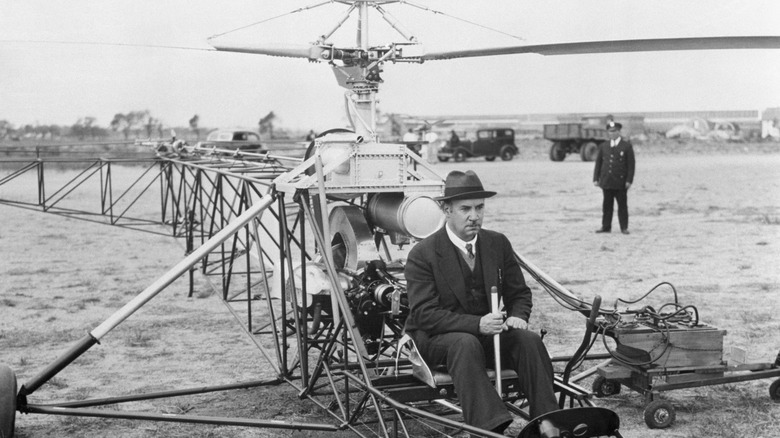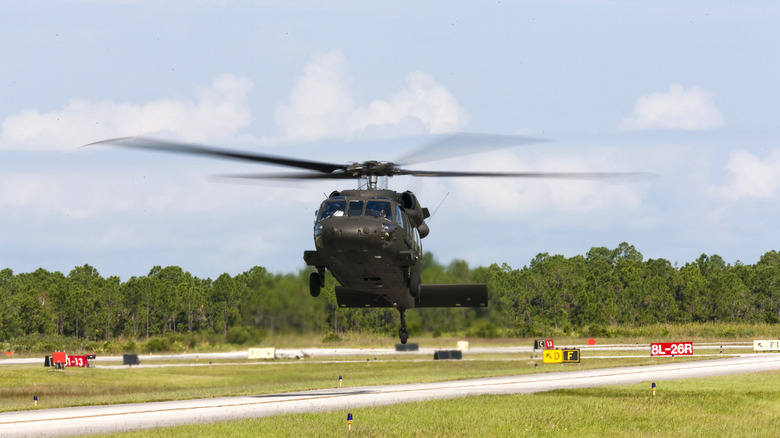Who Invented The First Modern Helicopter?
The famed Wright brothers made history in December 1903 with their inaugural flight at Kitty Hawk. Just over six decades later, our understanding of flight advanced so far that Yuri Gagarin became the first person to travel through space in 1961. Somewhere in between two of the greatest feats of flight history came another, and it's one that sometimes isn't celebrated as much as it should be: In 1939, Igor Sikorsky invented the first modern helicopter.
Ever since, Sikorsky's name has become synonymous with the helicopter, appearing on some of the highest-profile birds around. In fact, in August 2024, former U.S. President Joe Biden took his inaugural flight in a helicopter from the VH-92A Patriot fleet, which was chosen to serve as the Marine One. We're getting ahead of ourselves, though, because Sikorsky's very first helicopter was the VS-300. Taking to the skies in September 1939 with the determined Sikorsky himself at the controls, the VS-300 achieved something that countless other brilliant minds, including that of Leonardo da Vinci, dreamed up but couldn't realistically make happen: helicopter flight. The flight, like the historic one of the Wright brothers, was brief, but by achieving it, Sikorsky immortalized himself in aviation history.
However, there is one important caveat: This was not the very first powered helicopter flight to go as intended. That was achieved three years earlier, by the Model Fw-61 designed by Henrich Focke, Georg Wulf, and Dr. Werner Naumann. What Sikorsky did, though, was develop a design that would become a kind of blueprint for the modern helicopter.
How the historic VS-300 was designed
The complex problem of achieving true helicopter flight was one that wouldn't be solved easily. It's difficult enough to dream up a device that could potentially work in theory, but a functional machine that could sustain rotor-driven piloted flight was a new innovation entirely. Sikorsky found initial success not with helicopters, but with airplanes.This was a technology that, while proven, was still in its infancy. The Kyiv-born engineer was captivated by the idea of aviation, educated at both Kyiv's Mechanical Engineering College of the Polytechnical Institute and other European institutions as he traveled to master his future craft.
His S-series of planes went through various iterations, as such inventions typically do, until the S-6 drew acclaim at the 1912 Moscow Aviation Exhibition. This was the break that he needed to take his ambitious plans to the next level. Just over 10 years later, he established the Sikorsky Aero Engineering Corporation, headquartered in New York's Long Island. The Sikorsky's brand quickly established itself in the airplane world, but the key to developing a stable and reliable helicopter remained elusive until the late 1930s.
We now know that the tail rotor is a critical element of so many helicopters, helping pilots exert control over the finicky flight of their birds. This was the big addition to the VS-300 that cracked the code and made production a reality. It also separated Sikorsky's work from the few helicopters that existed around him. The aforementioned Model Fw-61 had two rotors next to each other, rather than Sikorsky's singular tail rotor design that would continue to be employed in other models.
The evolution of Sikorsky helicopters
Now that Sikorsky had proven his aircraft could sustain flight, the U.S. Army Air Force was eager to make use of it. The version that first served was the R-4, which saw action around the midpoint of World War II. Used by the British Royal Navy as well as by U.S. forces, the R-4B was known as the Hoverfly, or the Eggbeater to those who flew and commanded it. It had a range of just 130 miles, but its 200-horsepower Warner R-550 engine worked hard to propel it to 75 mph.
The humble Hoverfly was first to demonstrate the utility of a helicopter in warfare, mounting rescues in locations where airplanes couldn't hope to land. In the decades since, Sikorsky helicopters have had tremendous value both in offensive and defensive roles. The iconic Jolly Green Giant helicopter is a Sikorsky model, as well as very special models like the Black Hawk.
In November 2015, Sikorsky was acquired by Lockheed Martin in a heavyweight meeting of two aviation titans. As a result of this high-profile merger, Sikorsky was well-positioned to continue developing unique and formidable flying machines, as befits the legacy of Igor Sikorsky.


